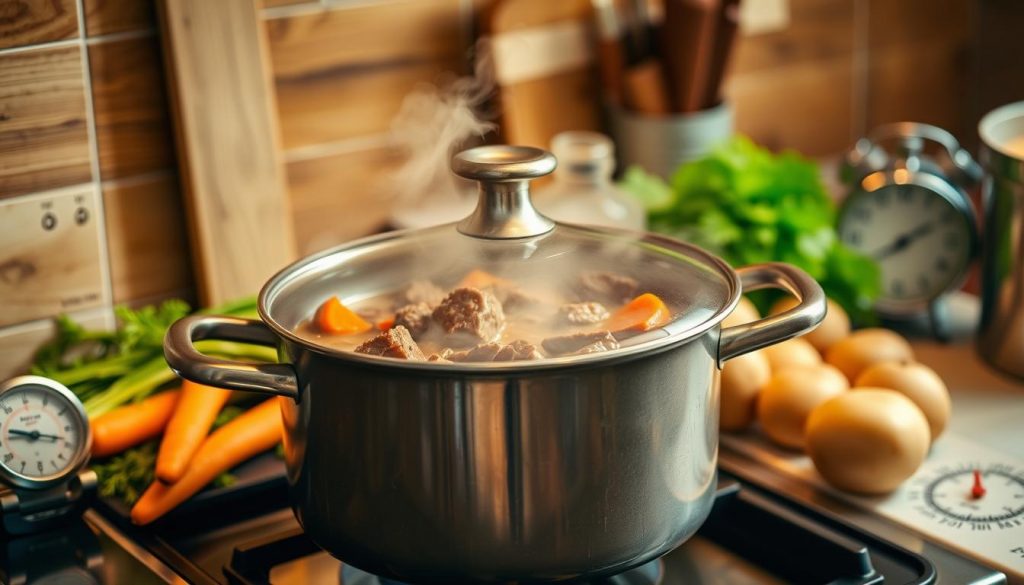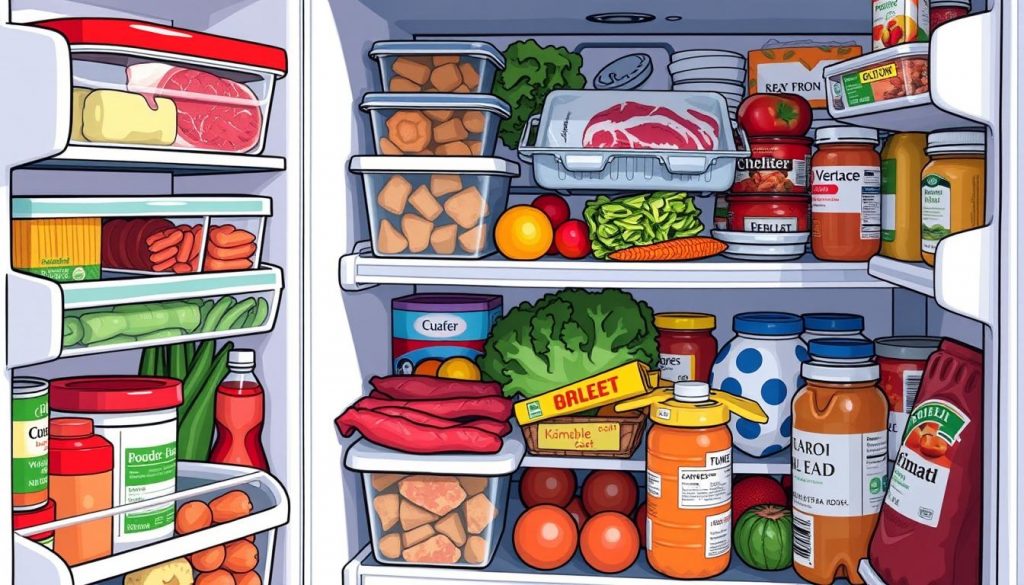Proper storage is vital for keeping beef stew tasty and safe. Let’s explore how to store this comfort food correctly. We’ll learn about refrigeration techniques to maintain its flavor and safety.
Food safety rules are crucial for leftover storage. Beef stew needs special care due to its mix of ingredients. We’ll guide you through storing this dish safely in your fridge.
We’ll cover the best temperature for stew storage. You’ll learn how to spot signs of spoilage. Our tips will help you extend your stew’s shelf life and quality.
With these tips, your reheated stew will taste as good as fresh. Let’s make sure your next bowl is safe and delicious!
Key Takeaways
- Proper storage extends beef stew’s fridge life
- Refrigerate stew within two hours of cooking
- Use airtight containers for best results
- Consume refrigerated stew within 3-4 days
- Check for signs of spoilage before eating
- Reheat stew thoroughly before serving
Understanding Beef Stew Storage Basics
Storing beef stew properly keeps it safe and tasty. Let’s explore how to keep this hearty dish fresh for days.
The Importance of Proper Storage Temperature
Your fridge’s temperature is crucial for preserving stew. Set it between 35°F and 38°F to slow bacterial growth. This range maintains flavor and safety.
Use a thermometer in your fridge to monitor the temperature accurately.
Container Selection for Stew Storage
Choose airtight, leak-proof containers to keep your stew fresh. Glass or BPA-free plastic containers work well. Some believe stews taste better with age.
Proper storage is key to enjoying potential flavor enhancements safely.
Cooling Before Refrigeration
Don’t put hot stew directly in the fridge. This can raise the internal temperature, potentially spoiling other foods. Cool your stew to room temperature within two hours of cooking.
For large batches, divide the stew into smaller containers to speed up cooling. Once cooled, refrigerate promptly to maintain food safety and quality.
| Storage Step | Time Frame | Temperature |
|---|---|---|
| Cooling | Within 2 hours | To room temperature |
| Refrigeration | After cooling | 35°F – 38°F |
Follow these storage basics to keep your beef stew safe and delicious. The right temperature, containers, and cooling process are key to proper food storage.
How Long Does Beef Stew Last in the Fridge
Proper storage of beef stew is key to safe eating and less food waste. Let’s explore how long you can keep your leftover stew in the fridge.
Beef stew typically stays good for 3-4 days in the fridge. This count starts when you put your fresh-cooked stew in the refrigerator. For best safety and taste, eat your stew within this time.
Several things can affect how long your stew lasts:
- Storage temperature: Keep your fridge at or below 40°F (4°C)
- Container type: Use airtight containers to prevent bacterial growth
- Cooling speed: Refrigerate stew within two hours of cooking
- Ingredient freshness: Fresher ingredients may extend shelf life slightly
These tips are helpful, but trust your senses too. If the stew smells bad before 3-4 days, throw it out. Your health is more important than saving food.
“When in doubt, throw it out. It’s better to waste a little food than risk foodborne illness.”
Following these rules helps you enjoy tasty beef stew for days after cooking. Good storage keeps your stew safe and delicious longer.
Signs of Spoiled Beef Stew
Recognizing food spoilage signs is vital for safety. This guide will help you spot stew freshness indicators. You’ll learn to avoid eating spoiled beef stew.
Visual Indicators of Spoilage
Start with a visual check of your stew. Look for fuzzy spots in various colors, which indicate mold growth. Discoloration is another warning sign to watch for.
If your stew’s color has changed unnaturally, it’s probably spoiled. Trust your eyes when inspecting your food.
Odor Changes to Watch For
Your nose can detect spoilage effectively. Fresh beef stew should smell savory and meaty. Sour, rancid, or putrid odors mean it’s time to toss the stew.
Trust your instincts. If something smells off, it’s likely not safe to eat.
Texture Alterations That Signal Spoilage
Texture changes can reveal spoilage too. Slimy feel or unusual consistency means the stew isn’t safe. Watch for ingredient separation or an oily film on top.
- Check for mold or discoloration
- Smell for off-putting odors
- Feel for slimy textures or separation
Learning these signs will help you spot spoiled stew easily. If you’re unsure, it’s best to throw it out.
Food safety is crucial. Don’t risk illness by eating questionable stew.
Best Practices for Storing Leftover Stew
Proper storage is crucial for tasty leftover stew. These tips will help you keep your stew safe and delicious. Let’s explore how to refrigerate beef stew effectively.
Cool your stew quickly before refrigerating. Split large batches into smaller containers to speed up cooling. This stops bacteria growth and keeps food safe.
Use airtight containers, leaving space at the top for expansion. Place stew in the coldest part of your fridge, usually the back.
Set fridge temperature to 40°F (4°C) or below. This keeps stew fresh for up to four days. Label containers with dates to track freshness.
- Use shallow containers for quicker cooling
- Avoid storing stew in metal pots to prevent metallic flavors
- Reheat only the portion you plan to eat
For longer storage, freeze your stew. It can last up to three months without losing taste or texture. Thaw in the fridge overnight and reheat thoroughly before eating.
“Proper storage is the key to enjoying your stew’s flavors days after cooking.”
These practices will extend your stew’s life and reduce waste. If unsure about freshness, it’s best to throw it out.
Freezing Beef Stew for Extended Storage
Freezing beef stew is a great way to keep it fresh longer. This method keeps the flavor and nutrients intact. Let’s look at how to freeze, store, and thaw your stew properly.
Proper Freezing Techniques
Cool your stew completely before freezing. Use freezer-safe containers and leave an inch of space at the top. Label containers with the date and contents for easy tracking.
Recommended Freezer Containers
Pick containers that seal well and can withstand freezing. Glass jars, plastic containers, or heavy-duty freezer bags are good choices. For single servings, try silicone muffin trays or ice cube trays.
| Container Type | Pros | Cons |
|---|---|---|
| Glass Jars | Reusable, non-toxic | Can break if dropped |
| Plastic Containers | Lightweight, stackable | May absorb odors |
| Freezer Bags | Space-saving, convenient | Not reusable |
Thawing Methods and Safety
Safety is crucial when thawing your frozen stew. The best way is to thaw it in the fridge overnight. For quick thawing, use your microwave’s defrost setting or cold water.
Avoid thawing stew at room temperature. This can cause harmful bacteria to grow quickly.
“Always reheat thawed stew to a rolling boil before serving to ensure any potential bacteria are destroyed.”
These tips will help you enjoy your homemade stew for months. Proper freezing, storage, and thawing keep your stew tasty and safe to eat.
Reheating Stored Beef Stew Safely
Reheating stew requires care to maintain safety and flavor. Let’s explore the best ways to reheat your savory beef stew. We’ll ensure it’s both delicious and safe to eat.

The key is reaching the right safe food temperature. Use a food thermometer to check that your stew reaches 165°F (74°C) throughout. This temperature kills harmful bacteria that might have grown during storage.
Here are some methods for reheating your beef stew:
- Stovetop: Heat slowly over medium heat, stirring occasionally
- Microwave: Use a microwave-safe container and heat in short intervals, stirring between each
- Oven: Place in an oven-safe dish, cover, and heat at 350°F (175°C)
Stir your stew periodically while reheating. This helps distribute heat evenly and prevents hot spots. It ensures all parts cook equally.
| Reheating Method | Estimated Time | Temperature Check |
|---|---|---|
| Stovetop | 10-15 minutes | Every 5 minutes |
| Microwave | 3-5 minutes | Every 1-2 minutes |
| Oven | 20-30 minutes | At 15 minutes |
Follow these guidelines for a delicious and safe reheated stew every time. If your stew has been in the fridge for more than 3-4 days, discard it. It’s better to be safe than risk foodborne illness.
Tips for Maximizing Stew Freshness
Keeping stew fresh is crucial for great taste and safety. Here are expert tips to help you maintain your beef stew’s quality.
Ingredient Quality Considerations
Begin with fresh, top-quality ingredients for your stew. Choose lean beef cuts and crisp veggies. Fresh components enhance flavor and extend shelf life.
Avoid using produce near spoiling. This can shorten your stew’s overall lifespan.
Storage Container Selection
Choose the right container for best storage results. Airtight, glass containers are perfect for keeping food fresh. They block odors and preserve your stew longer.
Don’t use metal containers for storage. They may react with acidic stew ingredients.
Temperature Management Tips
Temperature control is vital for stew freshness. Cool your stew quickly before refrigerating. Split large batches into smaller portions for faster cooling.
Keep your fridge at 40°F (4°C) or below. This slows down bacterial growth in your stew.
| Storage Method | Temperature | Maximum Storage Time |
|---|---|---|
| Refrigerator | 40°F (4°C) or below | 3-4 days |
| Freezer | 0°F (-18°C) or below | 2-3 months |
These tips will keep your beef stew fresh and tasty. Proper storage ensures food quality and safe eating.
Common Storage Mistakes to Avoid
Beef stew storage errors can lead to spoilage and waste. Let’s explore some common preservation mistakes and learn safe food handling practices.

Leaving stew at room temperature for too long is a major error. This creates an ideal environment for bacteria growth. Refrigerate your stew within two hours of cooking or serving.
Storing stew in large containers slows down cooling, increasing bacterial growth risk. Divide your stew into smaller portions for quicker cooling and easier reheating.
Using the wrong containers is another common mistake. Choose airtight, food-grade containers to prevent contamination and maintain freshness. Avoid metal containers, as they can react with acidic stew ingredients.
- Not labeling containers with dates
- Overfilling containers, leaving no room for expansion
- Reheating stew multiple times
- Storing stew on refrigerator door shelves where temperature fluctuates
Avoiding these mistakes can extend your beef stew’s shelf life. It also ensures the stew remains safe to eat. When in doubt, it’s better to discard any questionable stew.
| Mistake | Consequence | Solution |
|---|---|---|
| Leaving stew at room temperature | Rapid bacterial growth | Refrigerate within 2 hours |
| Using large containers | Slow cooling, increased spoilage risk | Use smaller, portion-sized containers |
| Improper container choice | Contamination, loss of freshness | Use airtight, food-grade containers |
| Not labeling with dates | Confusion about freshness | Always label with storage date |
Health Risks of Improperly Stored Stew
Storing beef stew incorrectly can pose serious food safety risks. Learning about these dangers helps prevent foodborne illness. Proper storage ensures your meals remain safe to eat.
Bacterial Growth Concerns
Stew spoilage occurs when bacteria multiply rapidly in warm temperatures. Leaving stew out for over two hours creates a breeding ground for harmful microorganisms.
Food Poisoning Symptoms
Eating spoiled stew can cause foodborne illness. Common symptoms include nausea, vomiting, and stomach cramps.
- Nausea and vomiting
- Stomach cramps
- Diarrhea
- Fever
- Dehydration
Symptoms usually appear within 6 to 24 hours after eating contaminated food. They can last for several days, causing discomfort and health issues.
When to Discard Stored Stew
Follow these guidelines to minimize food safety risks:
| Storage Method | Discard After |
|---|---|
| Refrigerated (40°F or below) | 3-4 days |
| Frozen (0°F or below) | 4-6 months |
| Room temperature | 2 hours |
Throw out stew that smells off, looks unusual, or has mold. If you’re unsure about its safety, it’s best to discard it.
Conclusion
Proper storage is crucial for enjoying your beef stew safely. Cool your stew quickly and store it in airtight containers. Refrigerate within two hours of cooking to maintain freshness.
Keep your stew at the right temperature and use suitable containers. This ensures your stew stays fresh for up to four days in the fridge. Freezing extends the stew’s life for several months.
These guidelines help you make the most of your homemade beef stew. Apply these tips to keep your leftovers safe and tasty. Enjoy your delicious stew for days after cooking!




